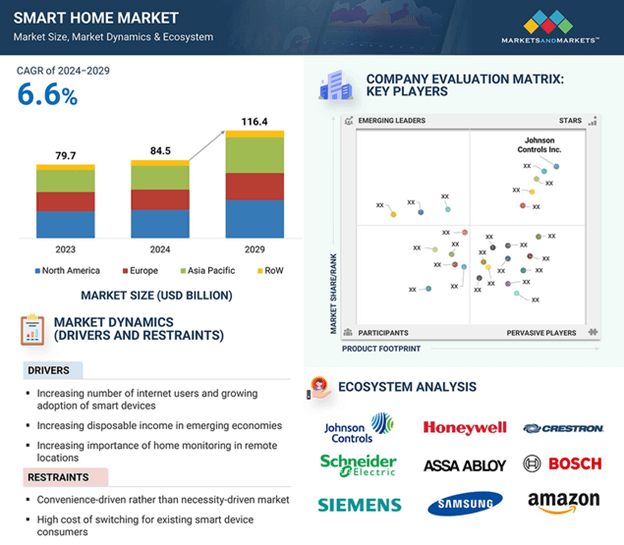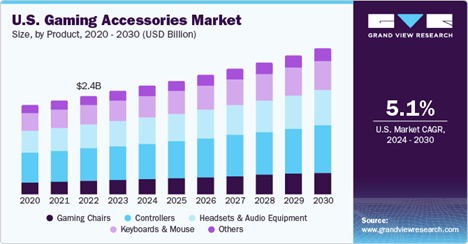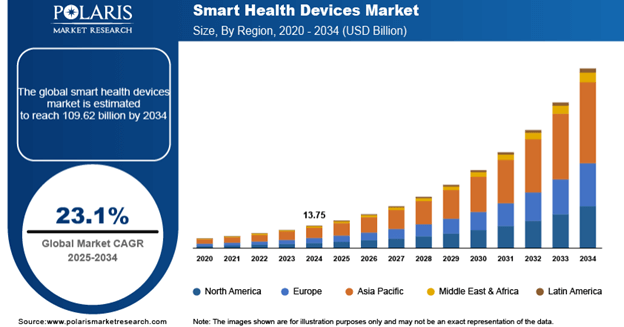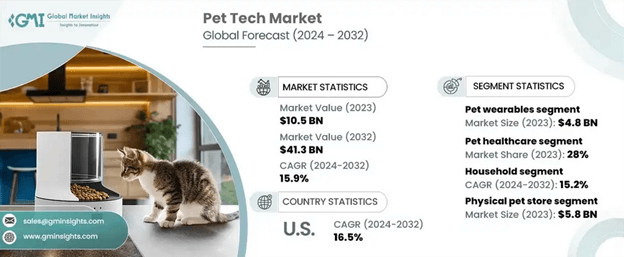
The consumer electronics sector is one of the largest in existence, surpassing $1.2 trillion in 2024 and growing at a compound annual growth rate (CAGR) of 6.6%. It's estimated to reach $1.78 trillion in just five short years.
From televisions and smartphones to smartwatches and kitchen appliances, consumer electronics are everywhere. Such a plethora of available products (and investment opportunities) could send any private equity firm searching for its niche into a tailspin.
That’s why we’re breaking down the most recent consumer electronics trends and some of the smaller, up-and-coming sub-sectors within the industry. Each of these niches is rich with investment opportunities, so let’s dive in.
For any short story fan, Ray Bradbury's There Will Come Soft Rains comes to mind when discussing the smart home. In it, Bradbury discusses what a (now-abandoned) smart house would look like in just a year past our current date, as of the time of writing (2026).
Once science fiction, many of Bradbury's predictions from 1950 are shockingly accurate: auto-notifications of dates, events, weather, and the time; robots cleaners furiously chasing away dust bunnies; recognition of the family dog to let into the house; and more.
Common offerings for "intelligent" home devices now include cleaning robots, smart thermostats, home security (video doorbells, cameras, etc.), kitchen appliances (Wi-Fi sous vides and crockpots, smart breadmakers, etc.), smart speakers, and more.
Smart device market growth is surging, with the sub-sector growing at the same rate as the consumer electronics industry as a whole at 6.6%. It’s expected to reach a size of $116 billion by 2029, according to Markets and Markets.

The largest sub-sector on our list, "smart home," also encompasses the widest range of products and the largest number of options. Nearly anything related to owning or living in a home or apartment could be included in the category, and options can vary wildly among different geographies.
Take, for instance, the US kitchen smart appliance market versus the Japanese one. Blenders, food processors, large electric mixers, etc., are all commonplace in the US kitchen. But in Japan, compact multi-taskers, rice cookers and other small, countertop gadgets are far more prevalent. Creativity abounds in the industry, with new inventions and innovations cropping up near-daily. Plus, shows such as Shark Tank have made releasing these to the public slightly more attainable for entrepreneurs.
There are other, wider smart home industry trends, however — such as an increase in home security concerns — that have caused some small increases in growth in the overall sector. Interestingly, AI has yet to make a real impact, as (despite Bradbury's predictions) the general public isn’t yet sold on the idea of artificial intelligence living in every appliance.
A Colorado-based electronics integrator specializing in home and business solutions, CDI Services offers intelligent home automation, security surveillance, and multi-room audio systems. Their clientele often includes homeowners, businesses, and construction companies seeking customized solutions to enhance security, entertainment, and operational efficiency.
Onkron manufactures high-quality TV stands, wall mounts, and workstations for business, government, and education sectors, enhancing efficiency, productivity, and user experience. The company specializes in large-scale mounts and systems for video walls, electronic navigation, and information displays.
EcoFlow is a leading provider of portable air conditioning solutions, offering a range of products including the WAVE 3, as well as solar panels and batteries. Designed for outdoor, home, and mobile living, EcoFlow's products enable customers to easily enhance their comfort, reduce energy costs, and upgrade their outdoor experiences.
Categorization within the gaming industry isn't as straightforward as the smart home space. “Gaming” may refer to the content itself (e.g., the games' software and media), consoles and handheld hardware, eSports and streaming, or the millions of other products that sit on the sidelines, including accessories, peripherals, and even tie-in products.
For this discussion, however, we're limiting it to the aspects of gaming that fit within consumer electronics: consoles and accessories. We also do not include the mobile gaming market (e.g., games designed for smartphones) due to its significant overlap with the smartphone and smartphone accessories sectors.
Within this focused lens, it's essential to understand the relative dominance that a few key industry players have in the gaming console market. Nintendo, Sony, and Microsoft are essentially it when it comes to mainstream gaming consoles. In contrast, the aftermarket and third-party accessory industry has thousands of companies across the world.
However, the gaming console industry itself is less than a quarter of the size of the smart home market, and is projected to reach just $24.8 billion this year, according to Statista. And, despite the number of companies operating within it, the accessories market — which includes products such as keyboards and mice, headsets, controllers, and even gaming chairs — is even smaller, with Grand View Research estimating it at $6.57 billion in 2023 and expecting it to grow at a CAGR of 6.3% to 2030.

The personal computing (PC) market has begun to overlap more with the console and handheld gaming industries, with offerings such as the Steam Deck, Asus ROG Ally, and many other options. It seems this trend will continue with Xbox's recent announcement of its handheld version of the console and commitment to redefining "what a gaming console really is."
Despite the numerous opportunities in the gaming market, its community is a passionate one, often characterized by fierce loyalty to specific brands. It does not tolerate poor business practices and will not only actively bring attention to a company whose product quality dips or customer service starts to lack, but also boycott that brand and encourage the rest of the community to do the same.
That said, for the savvy private equity firm well-versed in saving struggling businesses, these situations can turn into (potentially) lucrative opportunities.
Designers of the N-Gen gaming chairs, Neo Chair is a premium gaming chair brand specializing in high-quality chairs designed for gamers. Primarily operating in the US, the company also offers office and executive chairs that promote both comfort and durability, with designs available for those who want to showcase pop culture references.
Pwnage is a California-based company specializing in high-performance, lightweight gaming mice and accessories. Designed for gamers seeking to enhance their experience, the company's mice use both carbon fiber and magnesium to offer a premium feel with increased durability.
A Philippines-based company, Next Technologies specializes in high-quality gaming monitors and office monitors. The company offers a wide range of sizes, refresh rates, contrasts, and resolutions, with products designed for gamers, office users, and professionals across the Philippines.
The COVID-19 pandemic forced millions home for extended periods of time and caused health and wellness to become a top concern. It spurred tremendous growth for the industry with increased demand for products such as smart scales, fitness trackers, and more traditional fitness machines (treadmills, bikes, etc.).
Today, the digital health and lifestyle technology sector is growing at a huge CAGR of 23.1%, according to Polaris Market Research, and is expected to hit $109.6 billion by 2034.

Much like other sectors on our list, the smart health devices industry is diverse, with numerous offerings that blur the lines between the healthcare sector and the home health sector, including smart insulin pumps and CPAP machines.
Lingering trends from the pandemic, including the increased popularity of telehealth and remote monitoring options, are paving the way for health practitioner-assisted home healthcare and driving a rise in demand for smart devices. Issues such as obesity, lack of exercise, and other chronic diseases are also driving the sector's growth, with no signs of slowing down.
For firms considering entering this space, it's important to recognize the relatively few players at the top of the traditional health and fitness tech market: Peloton, Bowflex, and NordicTrack, for instance. The same is true for the fitness wearables space, which includes heavy hitters such as Fitbit (now owned by Alphabet), Garmin, and even the Kickstarter-originated Oura.
However, as Oura itself even shows, creativity again reigns supreme, and firms with an innovative mindset or with connections in other industries can successfully weave their way through the crowded sector.
With innovative health monitoring products like LIFELEAF and GlucoNow, which enable real-time tracking of cardiovascular and metabolic health, LifePlus offers high-tech solutions for healthcare providers and health-conscious individuals. Their main offerings feature a variety of devices, including wearables that continuously monitor vital signs such as blood pressure, glucose levels, and sleep apnea.
Composure designs products to enhance sleep for seniors through the transformative power of sound. Their flagship product, the Sound Blanket™, delivers evidence-based sounds designed to cue bedtime calm, promote sleep, and cover environmental distractions.
Specializing in infrared sauna therapy products, SaunaSpace offers a range of products including FireLight Infrared saunas, Hearth sauna panels, and LED lighting solutions. Designed for comfort, relaxation, and therapeutic purposes, individuals use SaunaSpace's products to enhance their physical and mental health, enhance physical wellness, and reduce cellulite.
When innovative technology reaches consumers' hands, it usually skyrockets in popularity. Drones were no exception when they first blew onto the market in the early 2000s. A sizable upgrade from the RC planes that aerospace enthusiasts were using, drones' applications have gone far beyond simply taking a bird's eye view of backyards.
Shipping and logistics, filmmaking, construction, and even real estate and landscaping have all taken note of drone industry trends and successfully adopted these devices as regular parts of their kits. As such, the industry has grown significantly, with Grand View Research estimating the market at $73.06 billion in 2024 and projecting it to reach $163.6 billion by 2030.

Similar to other sectors on our list, the drone market is largely dominated by two names — DJI and Parrot, in this case — though there are other, smaller brands emerging.
While drones have made their way into countless industries, many have raised flags about privacy concerns. There are drones that operate akin to their RC cousins, where they must be seen to operate responsibly. But many, including those intended for applications outside consumer tech, rely on the use of cameras.
Additionally, drones' relatively lightweight frames and low load capacities make them less suitable for large-scale logistics use. However, they have found their place in specialized cases, though many of the drones fit for this purpose are prohibitively expensive for consumers.
For any private equity firm looking for a sector with a lot of opportunity — much of it yet to be realized — the drone sector has it in spades. This is especially true if your firm has ties to any sector that may already use or is beginning to explore using these devices.
Balko Tech specializes in modular LiDar systems for drones that are designed to enhance geospatial data collection for various sectors such as transport, forest management, and construction. Users can easily integrate Balko Tech's mods for laser interchanges, inertial navigation systems (INS) and cameras on their drones.
Primarily offering drone-enabled services, Rotors & Cams offers flexible and cost-effective solutions for surveying electrical networks, industrial sites, farmlands, and structures. Their drones are equipped with standard and thermal imaging cameras, along with specialized sensors, for capturing high-quality images and videos for customers in security, agriculture, and geography.
Specializing in aerial spraying drones, particularly the EAVision J100 and the Enterprise Autel EVO, Agri Spray Drones caters to farmers and the agriculture industry. Designed for high-efficiency and multi-mission capabilities, such as such as surveying, spraying, and spreading, their drones are used throughout the United States and Canada.
Humans have domesticated animals for thousands of years — consider the Egyptians' famous reverence for cats. In the US, almost half (45%) of homes have at least one dog, nearly a third (32%) have at least one cat, and it's estimated that the global pet population is around 1 billion.
As technology has evolved, how humans take care of their animals (including fish, birds, rabbits, and rodents, as well as the traditional cats and dogs) has advanced. Smart feeders, automated litter boxes, health monitors, cameras, toys, etc., are all part of today's pet industry trends and pet tech market.
According to Global Market Insights, the pet tech market reached $10.5 billion in 2023 and is forecasted to grow at a rapid 16.5% CAGR through 2032.

With so many different types of pets in households today, the opportunity for private equity within pet tech is large, especially for those with an aptitude for innovation. The pet tech market shows strong signs of growth, and, although they're not directly correlated, the declining birth rate and increasing pet population suggest the industry will continue to expand.
Similar to the gaming industry, pet owners are passionate about their animals, often considering them akin to "furry children" rather than lesser members of the household. As such, when products are not well-received, or even dangerous, it's very easy for that company to fold.
However, this affection also means that pet owners are more likely to spend their disposable income on their pets, offering opportunities for firms that invest in reputable companies that produce high-quality products.
Formerly known as SmartyPear, Casa Leo is a self-cleaning litter company that specializes in the Leo's Loo and Leo’s Loo Too. Designed to ease the less fun parts of cat care, the company's smart litter boxes offer innovative litter solutions for cat owners across the US.
Current USA, operating under Saltwater Aquarium, offers high-quality LED lights, water pumps, and aquascaping decor for fish and live plants in both freshwater and saltwater aquariums. The company offers a wide range of LED lighting solutions, including the Orbit Marine and Orbit R24 LED, designed to enhance natural color rendition and enhance growth in fish and plants.
Boxiecat is a Santa Monica-based company specializing in cat litter solutions, offering a range of products including self-cleaning and natural odor control solutions. Their offerings cater to cat owners and pet owners seeking high-quality, hypoallergenic, and sustainable solutions for their pets.
Finding your niche within a vast industry like consumer electronics requires research, market mapping, and creating an investment thesis. Once your firm has its focus, it's time to identify your next opportunity and get in contact.
One great way of doing this is through industry events. See what conferences are still in store for 2025 with our list of the Top Consumer Electronics Conferences.